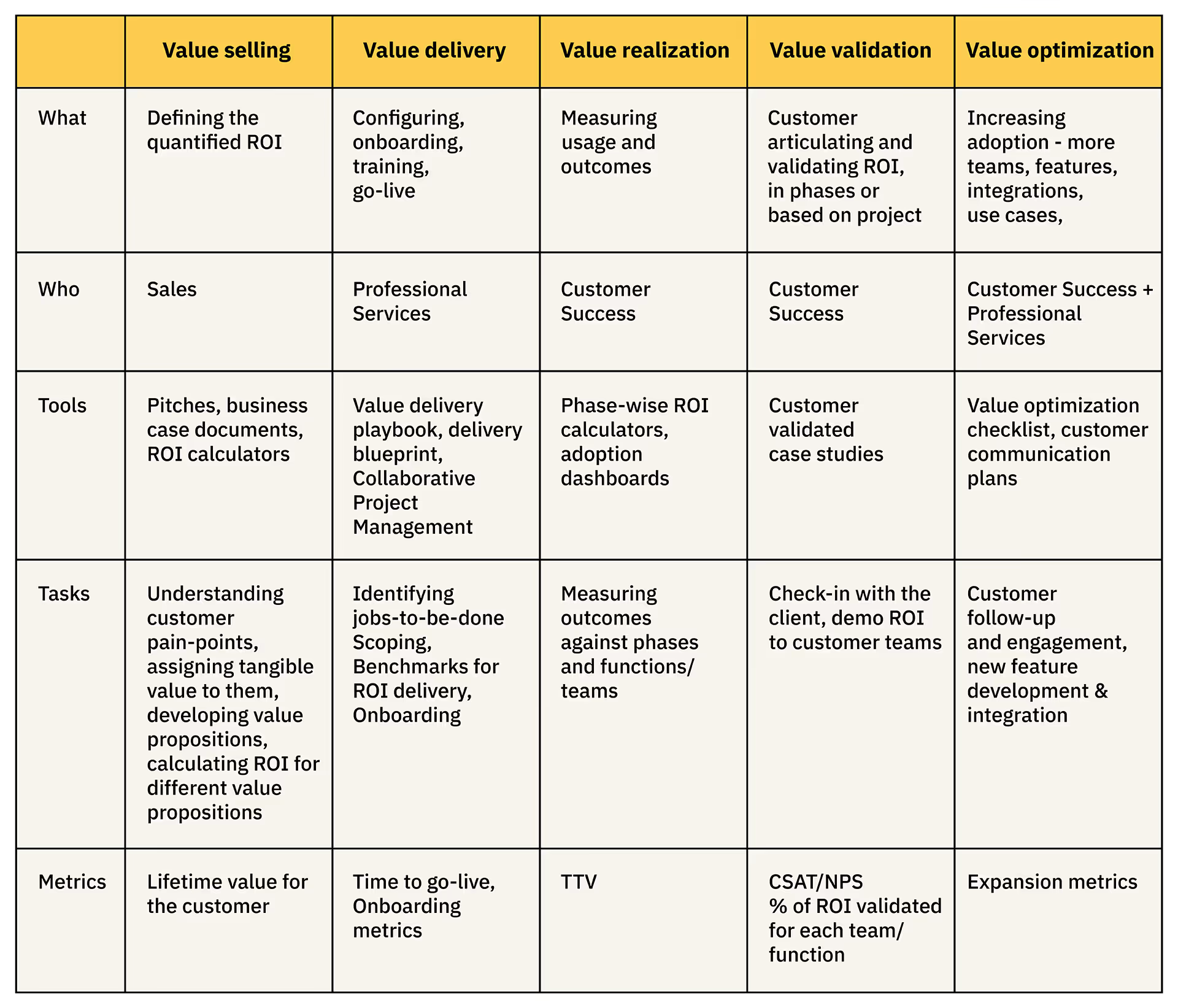Whether you want to win new customers, increase subscription renewals, or maintain and grow your account, value realization lies at the core of your customer success strategy.
But it’s not just about your customer success team. You must weave value-centricity into your organizational culture–from marketing and sales to implementation, account management, and customer success. Again, this goes back to delivering exceptional outcomes and experiences every step of the way.
In the first part of this two-part series, we looked at the five phases of value realization. In this article, we look at the specifics: objectives, tasks, tools, and metrics for each of these.

Based on this framework, in the rest of this article, we look at the tasks, tools, and metrics that you can use to implement this framework. Let’s get started.
1. Value Selling
Unlike conventional sales tactics, value-based selling requires listening to customers, identifying their problems, and using this to demonstrate your product’s value to meet their wants and needs. You need to curate solutions for your customer, not overwhelm them with all the features and ask them to pick what they need.
Things to do
The key here is to narrow down what you want to focus on and quantify the ROI for the customer. Let’s say your service costs their company $20000 per year. Yet, if your customer earns $100,000 a year due to your service, they get $80,000 of profit. That’s a noticeable return on investment of 400% that they won’t want to give up.
While figuring out ROI can be tricky and subjective, Your value offering will broadly fall into one or more of the following:
- Increase revenue
- Decrease cost
- Improve productivity
- Minimize risks
Here are some guiding questions that can help you identify the customer pain points and the area to focus on for ROI calculation:
- What percentage of your customers drop off at X?
- What percent of your budget is spent on Y?
- How many hours per week does your team spend on Z?
- How many members handle X for your team?
- How many separate licenses/users do you pay for?
- If you solved X, how much would that be worth to you?
- If you could change one part of your business, what would it be?
This is by no means an exhaustive list; the key is to talk to your biggest customers and understand their processes, software stack, and current issues. The key is to assign a tangible value to these pain points. This way, you can help them understand the cost of their problems and the return they can expect from switching to your solution. The key here is to move away from features and functionalities to problems, solutions, and ROI.
Tools to develop
- ROI calculators
- Pitches, business case studies
- Trials and demos
Metrics to track
From a value-driven sales perspective, here are some of the metrics to track at your end:
- Conversion rate (say, from leads to trials to sales)
- Customer Lifetime Value
- Customer Acquisition Rate
2. Value Delivery
The goal of the value delivery stage is not just about configuring and onboarding but driving adoption and sustained usage.
Things to do
The key activities at this stage include:
- Understanding and mapping the customer’s pain points
- Identifying jobs to be done
- Project kickoff
- Scoping the project
- Setting ROI benchmarks for phases and/or functions/teams
- Onboarding
- Supporting adoption and usage
- Checking in with customers not meeting certain thresholds of activity
The two critical elements of this phase are the project kickoff for onboarding and scoping for go-live. Our articles on running a successful onboarding project kickoff and defining project scope delve into this in greater detail.
Tools to develop
- Delivery blueprint
- Onboarding and training plan
- Phase/function-wise ROI milestone framework
- Collaborative project management/collaborative onboarding platform
Metrics to track
- Onboarding metrics
- Time to go-live
- Active users (Daily Active Users, Monthly Active Users)
3. Value Realization
It is at this stage that the customer starts seeing and accruing value. It is important to demonstrate value to the customer and help them realize it through check-ins and support.
Things to do
- Understanding adoption and usage
- Support/training to address any blockers
- Measuring and demonstrating ROI - phase and/or function-wise
- Identifying successful use cases for case studies for the next phase
Tools to develop
- Adoption and usage dashboard
- Phase/function-wise ROI calculators
Metrics to track
4. Value Validation
This is the stage where a satisfied customer goes from just using your product to actively advocating for you. Whether it is for phases or for different functions/teams within the customer’s org, this is the time to get your customer to validate the value they have unlocked through your product.
Besides being a great way to drive further adoption, it is an opportunity for the customer champion to show the rest of their organization that the project has had positive outcomes and impacted the company’s bottom line.
This step feeds back into your Value Selling stage for prospective customers, so it’s important to showcase an ROI and case study that is attractive to your potential customers.
Things to do
- Validate ROI with customer leadership
- Demonstrate ROI to customer teams
- Develop case studies—for the customer and your organization
Tools to develop
- Customer validated case studies
Metrics to track
5. Value Optimization
With accurate scoping, sustained support, and the right milestones, you should now be well on your way to having engaged and satisfied customers. This means that there are now ways for you to deliver more value by optimizing: by expanding adoption and helping the customer solve more problems, improve efficiency, and unlock more benefits.
Things to do
- Increasing adoption—more teams, features, integrations, use cases
- Development of new features and integrations
Tools to develop
- A value optimization checklist
- Customer communication plans—for follow-ups and future engagement
A holistic approach
Developing a value-focused customer success model is both highly subjective and fluid. No one solution is guaranteed to work for every company and its customers. However, placing the focus squarely on the customer and the value you can provide them is the best place to start.
We hope the learnings from our journey and the framework and tools recommended in this series help you develop a framework that works for the unique needs of your business. Having a guiding framework that you can learn from and iterate can improve your customer success strategy.
A value-focused framework forces you to look at the customer holistically and establish a strong data-driven foundation for all phases of the customer journey: adoption, usage, value realization, renewal, and expansion. With time and experience, you will begin to identify similar customer needs and proactively create standardized solutions for your biggest customers.

























.webp)